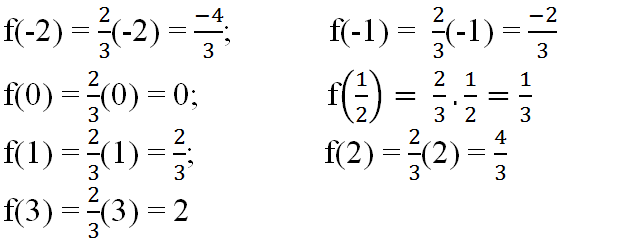Hãy nhập câu hỏi của bạn vào đây, nếu là tài khoản VIP, bạn sẽ được ưu tiên trả lời.

c) Từ kết quả câu a, b ta được bảng sau:
Nhận xét:
- Các hàm số y = f(x) = 2/3 x và y = g(x) = 2/3 x + 3 là hai hàm số đồng biến vì khi x tăng thì y cũng nhận được các giá trị tương ứng tăng lên.
- Cùng một giá trị của biến x, giá trị của hàm số y = g(x) luôn luôn lớn hơn giá trị tương ứng của hàm số y = f(x) là 3 đơn vị.
a) Cho hàm số : \(y=f\left(x\right)=\dfrac{2}{3}x\)
Ta có : \(f\left(-2\right)=\dfrac{2}{3}.\left(-2\right)=-\dfrac{4}{3}\)
\(f\left(-1\right)=\dfrac{2}{3}.\left(-1\right)=-\dfrac{2}{3}\)
\(f\left(0\right)=\dfrac{2}{3}.0=0\)
\(f\left(\dfrac{1}{2}\right)=\dfrac{2}{3}.\dfrac{1}{2}=\dfrac{1}{3}\)
\(f\left(1\right)=\dfrac{2}{3}.1=\dfrac{2}{3}\)
\(f\left(2\right)=\dfrac{2}{3}.2=\dfrac{4}{3}\)
\(f\left(3\right)=\dfrac{2}{3}.3=2\)
b) Cho hàm số : \(y=g\left(x\right)=\dfrac{2}{3}x+3\)
\(g\left(-2\right)=\dfrac{2}{3}.\left(-2\right)+3=\dfrac{5}{3}\)
\(g\left(-1\right)=\dfrac{2}{3}.\left(-1\right)+3=\dfrac{7}{3}\)
\(g\left(0\right)=\dfrac{2}{3}.0+3=3\)
\(g\left(\dfrac{1}{2}\right)=\dfrac{2}{3}.\dfrac{1}{2}+3=\dfrac{10}{3}\)
\(g\left(1\right)=\dfrac{2}{3}.1+3=\dfrac{11}{3}\)
\(g\left(2\right)=\dfrac{2}{3}.2+3=\dfrac{13}{3}\)
\(g\left(3\right)=\dfrac{2}{3}.3+3=5\)
c) Khi \(x\)lấy cùng một giá trị thì giá trị của \(g\left(x\right)\) lớn hơn giá trị của \(f\left(x\right)\) là \(3\) đơn vị.

Lời giải:
a)
\(f(-3)=(-3)^2=9; f(-\frac{1}{2})=(\frac{-1}{2})^2=\frac{1}{4}\)
\(f(0)=0^2=0\)
\(g(1)=3-1=2; g(2)=3-2=1; g(3)=3-3=0\)
b)
\(2f(a)=g(a)\)
\(\Leftrightarrow 2a^2=3-a\)
\(\Leftrightarrow 2a^2+a-3=0\Leftrightarrow (2a+3)(a-1)=0\)
\(\Rightarrow \left[\begin{matrix} a=\frac{-3}{2}\\ a=1\end{matrix}\right.\)

Câu 1a thì được nè :v
( 3x + 1)( 4x + 1)( 6x + 1)( 12x + 1) = 2
⇔ 4( 3x + 1)3( 4x + 1)2( 6x + 1)( 12x + 1) = 2.4.3.2
⇔ ( 12x + 4)( 12x + 3)( 12x + 2)( 12x + 1) =48 ( 1)
Đặt : 12x + 1 = a , ta có :
( 1) ⇔ a( a+ 1)( a + 2)( a + 3) = 48
⇔ ( a2 + 3a)( a2 + 3a +2) = 48
Đặt : a3 + 3a = t , ta có :
t( t +2) =48
⇔ t2 + 2t - 48 = 0
⇔ t2 - 6t + 8t - 48 = 0
⇔ t( t - 6) + 8( t - 6) = 0
⇔ ( t - 6)( t + 8) = 0
⇔ t = 6 hoặc t = -8
Tự thế vào mà tìm a sau đó suy ra x nha
Bài 1:
b)
HPT \(\left\{\begin{matrix} x^2+\frac{1}{y^2}+\frac{4x}{y}=2\\ 2\left(x+\frac{1}{y}\right)+\frac{x}{y}=3\end{matrix}\right.\)
\(\Leftrightarrow \left\{\begin{matrix} \left(x+\frac{1}{y}\right)^2+\frac{2x}{y}=2\\ 2\left(x+\frac{1}{y}\right)+\frac{x}{y}=3\end{matrix}\right.\)
Lấy PT(1) trừ 2PT(2) thu được:
\(\left(x+\frac{1}{y}\right)^2-4\left(x+\frac{1}{y}\right)=-4\)
\(\Leftrightarrow \left(x+\frac{1}{y}-2\right)^2=0\Rightarrow x+\frac{1}{y}=2\)
Thay vào thu được \(\frac{x}{y}=-1\)
Theo định lý Viete đảo thì \((x,\frac{1}{y})\) là nghiệm của PT:
\(X^2-2X-1=0\)
\(\Rightarrow (x,\frac{1}{y})=(1+\sqrt{2}; 1-\sqrt{2})\) hoặc \((1-\sqrt{2}; 1+\sqrt{2})\)
Tức là: \((x,y)=(1+\sqrt{2}, -1-\sqrt{2}); (1-\sqrt{2}; -1+\sqrt{2})\)

Xét pt tọa độ giao điểm:
X²=(m+4)x-2m-5
<=> -x²+(m+4)x-2m-5
a=-1. b= m+4. c=2m-5
Để pt có 2 No pb =>∆>0
=> (m+4)²-4×(-1)×2m-5>0
=> m² +2×m×4+16 +8m-20>0
=> m²+9m -2>0
=> x<-9 và x>0

a, \(A=\left(\frac{1}{\sqrt{x}+2}-\frac{1}{\sqrt{x}-2}\right):\frac{-\sqrt{x}}{x-2\sqrt{x}}\)
\(A=\left(\frac{\sqrt{x}-2}{\left(\sqrt{x}+2\right)\left(\sqrt{x}-2\right)}-\frac{\sqrt{x}+2}{\left(\sqrt{x}-2\right)\left(\sqrt{x}+2\right)}\right):\frac{-\sqrt{x}}{\sqrt{x}\left(\sqrt{x}-2\right)}\)
\(A=\frac{\sqrt{x}-2-\sqrt{x}-2}{\left(\sqrt{x}+2\right)\left(\sqrt{x}-2\right)}\cdot\frac{-\sqrt{x}\left(\sqrt{x}-2\right)}{\sqrt{x}}\)
\(A=\frac{4}{\sqrt{x}+2}\)
b, \(A=\frac{4}{\sqrt{x}+2}=\frac{2}{3}\)
=> 2cawn x + 4 = 12
=> 2.căn x = 8
=> căn x = 4
=> x = 16 (thỏa mãn)
c, có A = 4/ căn x + 2 và B = 1/căn x - 2
=> A.B = 4/x - 4
mà AB nguyên
=> 4 ⋮ x - 4
=> x - 4 thuộc Ư(4)
=> x - 4 thuộc {-1;1;-2;2;-4;4}
=> x thuộc {3;5;2;6;0;8} mà x > 0 và x khác 4
=> x thuộc {3;5;2;6;8}
d, giống c thôi

a) Để hàm xác định thì \(\hept{\begin{cases}x\ge0\\\sqrt{x}-1\ne0\end{cases}}\Leftrightarrow\hept{\begin{cases}x\ge0\\x\ne1\end{cases}}\)
b) Ta có: \(f\left(x\right)=\frac{\sqrt{x}+1}{\sqrt{x}-1}\)
\(\Rightarrow f\left(4-2\sqrt{3}\right)=\frac{\sqrt{4-2\sqrt{3}}+1}{\sqrt{4-2\sqrt{3}}-1}=\frac{\sqrt{\left(\sqrt{3}-1\right)^2}+1}{\sqrt{\left(\sqrt{3}-1\right)^2}-1}=\frac{\sqrt{3}}{\sqrt{3}-2}\)
và \(f\left(a^2\right)=\frac{\sqrt{a^2}+1}{\sqrt{a^2}-1}=\frac{\left|a\right|+1}{\left|a\right|-1}\)(với \(a\ne\pm1\))
* Nếu \(a\ge0;a\ne1\)thì \(f\left(a^2\right)=\frac{a+1}{a-1}\)
* Nếu \(a< 0;a\ne-1\)thì \(f\left(a^2\right)=\frac{a-1}{a+1}\)
c) \(f\left(x\right)=\frac{\sqrt{x}+1}{\sqrt{x}-1}=\frac{\sqrt{x}-1+2}{\sqrt{x}-1}=1+\frac{2}{\sqrt{x}-1}\)
Để f(x) nguyên thì \(\frac{2}{\sqrt{x}-1}\)nguyên hay \(2⋮\sqrt{x}-1\Rightarrow\sqrt{x}-1\inƯ\left(2\right)=\left\{\pm1;\pm2\right\}\)
Mà \(\sqrt{x}-1\ge-1\)nên ta xét ba trường hợp:
+) \(\sqrt{x}-1=-1\Rightarrow x=0\left(tmđk\right)\)
+) \(\sqrt{x}-1=1\Rightarrow x=4\left(tmđk\right)\)
+) \(\sqrt{x}-1=2\Rightarrow x=9\left(tmđk\right)\)
Vậy \(x\in\left\{0;4;9\right\}\)thì f(x) có giá trị nguyên
d) \(f\left(x\right)=\frac{\sqrt{x}+1}{\sqrt{x}-1}\); \(f\left(2x\right)=\frac{\sqrt{2x}+1}{\sqrt{2x}-1}\)
f(x) = f(2x) khi \(\frac{\sqrt{x}+1}{\sqrt{x}-1}=\frac{\sqrt{2x}+1}{\sqrt{2x}-1}\Leftrightarrow\left(\sqrt{x}+1\right)\left(\sqrt{2x}-1\right)=\left(\sqrt{x}-1\right)\left(\sqrt{2x}+1\right)\)\(\Leftrightarrow\sqrt{2}x+\sqrt{2x}-\sqrt{x}-1=\sqrt{2}x-\sqrt{2x}+\sqrt{x}-1\)\(\Leftrightarrow\sqrt{2x}-\sqrt{x}=-\sqrt{2x}+\sqrt{x}\Leftrightarrow2\sqrt{2x}=2\sqrt{x}\Leftrightarrow\sqrt{2x}=\sqrt{x}\Leftrightarrow x=0\)(tmđk)
Vậy x = 0 thì f(x) = f(2x)

d, \(\frac{3x}{x+2}=\frac{3\left(x+2\right)-6}{x+2}=3-\frac{6}{x+2}\)
\(\Rightarrow x+2\inƯ\left(6\right)=\left\{\pm1;\pm2;\pm3;\pm6\right\}\)
| x + 2 | 1 | -1 | 2 | -2 | 3 | -3 | 6 | -6 |
| x | -1 | -3 | 0 | -4 | 1 | -5 | 4 | -4 |
e, \(C=\frac{A}{B}>0\Rightarrow\frac{3x}{x+2}.\frac{x+2}{x^2+2}=\frac{3x}{x^2+2}>0\)
\(\Rightarrow3x>0\Rightarrow x>0\)vì \(x^2+2>0\)
Kết hợp với đk vậy \(x>0;x\ne\pm2\)
f, vừa hỏi thầy, nên quay lại làm nốt :>
f, Để \(\left|C\right|>C\Rightarrow C< 0\)vì \(\left|C\right|\ge0\)
\(\Rightarrow C=\frac{3x}{x^2+2}< 0\Rightarrow3x< 0\Leftrightarrow x< 0\)


Đáp án C
Ta có:
Vậy có 2 giá trị của thỏa mãn.